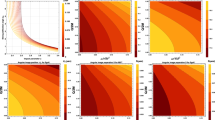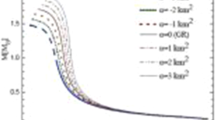Abstract
The present paper deals with the stationary solution of the planar restricted three body problem when both the primaries are heterogeneous oblate spheroid with three layers of different densities and sources of radiation as well. It derives equations of motion and examines the existence and the linear stability of libration points. It is seen that there are five libration points, two triangular points and three collinear ones. It is further observed that the collinear points are unstable, while the triangular points are stable for the mass parameter 0 ≤ μ < μ c r i t . Here μ c r i t (the critical mass parameter) depends upon the combined effects of radiation and that due to the three different layers in the primaries. It is further seen that long or short periodic elliptical orbits emanate from the triangular points in the aforementioned range of μ.








Similar content being viewed by others
References
Abouelmagd, E.I.: Existence and stability of triangular points in the restricted three-body problem with numerical application. Astrophys. Space Sci. 342, 45–53 (2012)
Abouelmagd, E.I.: The effect of photogravitational force and oblateness in the perturbed restricted three-body problem. Astrophys. Space Sci. 346, 51–69 (2013)
Chernikov, Yu. A.: The photogravitational restricted three body problem. Soviat Astron. A. J. 14, 1 (1970)
Bhatnagar, K.B., Chawla, J.M: A study of Lagrangian points in the photogravitational restricted three body problem. Indian J. Appl. Math. 10 (11), 1443–1451 (1979)
Das, M.K., Narang, P., Mahajan, S., Yuasa, M.: Effect of radiation on the stability of equilibrium points in the binary stellar systems: RW-Monocerotis, Krger 60. Astrophys. Space Sci. 314, 261 (2008)
Idrisi, M.J., Taqvi, Z.A.: Restricted three-body problem when one of the primaries is an ellipsoid. Astrophys. Space Sci. 348, 41 (2013)
Khanna, U., Bhatnagar, K.B.: Existence and stability of libration points in the restricted three- body problem when the smaller primary is a triaxial rigid body and the bigger one an oblate spheroid. Indian J. Pure. Appl. Math. 30 (7), 721–733 (1999)
Kushvah, B.S.: The effect of radiation pressure on the equilibrium points in the generalised photogravitational restricted three body problem. Astrophys. Space Sci. 318, 41 (2008)
McCuskey, C.W.: Introduction to Celestial mechanics. Addison-Wesley publication Company, INC (1963)
Murray, C.D.: Dynamical effects of drag in the circular restricted three-body problem. I. Location and Stability of the Lagrangian Equilibrium Points. Icarus. 112(2), 465 (1994)
Poynting, J.H.: Radiation in the solar system: its effect on temperature and its pressure on small bodies. Philos. Trans. R. Soc. Lond. 202, 525 (1903)
Radzievskii, V.V.: The restricted problem of three bodies taking account of light pressure. Akad. Nauk USSR, Astron. J. 27, 250 (1950)
Radzievskii, V.V.: The photo-gravitational restricted three-body problem. Astron. ž. 30(3), 265 (1953)
Ragos, O., Zagouras, C.: Periodic solutions about the out of plane equilibrium points in the photo-gravitational restricted three-body problem. Celest. Mech. 44(1–2), 135–154 (1988)
Ragos, O., Zafiropoulos, F.A.: A numerical study of the influence of the Poynting-Robertson effect on the equilibrium points of the photogravitational restricted three-body problem: I. Coplanar case. Astron. Astrophys. 300, 568–578 (1995)
Ragos, O., Zafiropoulos, F.A., Vrahatis, M.N.: A numerical study of the influence of the Poynting-Robertson effect on the equilibrium points of the photo-gravitational restricted three-body problem: II. Out of plane case. Astron. Astrophys. 300, 579–590 (1995)
Schuerman, D.W.: The restricted three body problem including radiation pressure. Astrophys. J. 238, 337 (1980)
Sharma, R.K., Subba Rao, P.V.: Collinear equilibria and their characteristic exponents in the restricted three-body problem when the primaries are oblate spheroids. Celest. Mech. 12(2), 189–201 (1975)
Sharma, R.K., Subba Rao, P.V.: A case of commensurability induced by oblateness. Celest. Mech. 18, 185–194 (1978)
Simmons, J.F.L., McDonald, A.J.C., Brown, J.C.: The restricted 3-body problem with radiation pressure. Celest. Mech. 35, 145–187 (1985)
Singh, J., Taura, J.J.: Motion in the generalized restricted three-body problem. Astrophys. Space Sci. 343, 95–106 (2013)
Szebehely, V.: Theory of orbits. Academic Press, San Diego (1967)
Author information
Authors and Affiliations
Corresponding author
Appendix
Appendix
List of co-efficient of equations of Section “Location of Collinear Points” :
Rights and permissions
About this article
Cite this article
Suraj, M.S., Hassan, M.R. & Asique, M.C. The Photo-Gravitational R3BP when the Primaries are Heterogeneous Spheroid with Three Layers. J of Astronaut Sci 61, 133–155 (2014). https://doi.org/10.1007/s40295-014-0026-9
Published:
Issue Date:
DOI: https://doi.org/10.1007/s40295-014-0026-9




